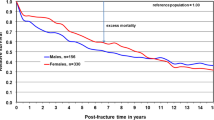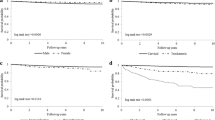Abstract
Clinical spectrum, treatment and short-term outcomes were assessed among the 131 Rochester, Minnesota, men who contracted an initial hip fracture due to moderate trauma during 1978–89. Three-fourths of falls leading to hip fracture occurred indoors with little seasonality, and 91% of fractures were in men 65 years of age or older. The ratio of cervical to intertro-chanteric femur fractures was 1.4:1, and there was a tendency toward more neurological conditions among the patients with cervical fractures. Hemiarthroplasty and total hip replacement were mostly performed for cervical fractures, while internal fixation was preferred for intertrochanteric fractures. In-hospital mortality was 11.5%, and the 30-day case fatality rate was 16.0%. Age and postoperative deterioration of mental status significantly increased the risk of early death, the latter even after adjustment in a multivariate model, while comorbidity had a suggestive but not statistically significant influence on mortality. More than half the men were discharged to nursing homes, and 79% of the patients who survived at 1 year resided in nursing homes or intermediate care facilities or were attended by home care. Only 41% of survivors recovered their prefracture level of functioning and nearly 60% of patients limped and required a cane or walker. After implementation of the prospective payment system in 1984, the length of hospital stay was reduced, but there was no change in early mortality rates, in the duration of physical therapy following fracture or in attendance at nursing homes. The results of this population-based study demonstrate the strong impact of hip fractures on short-term outcomes in men.
Similar content being viewed by others
References
Melton LJ III. Hip fractures: a worldwide problem today and tomorrow. Bone 1993;14:S1–8.
Praemer A, Turner S, Rice DP. Costs of musculoskeletal conditions. In: Praemer A, Turner S, Rice DP. Musculoskeletal conditions in the United States. Park Ridge: American Academy of Orthopaedic surgeons, 1992:143–70.
Cummings SR, Kelsey JL, Nevitt MC, O'Dowd KJ. Epidemiology of osteoporosis and osteoporotic fractures Epidemiol Rev 1985;7:178–208.
Cooper C, Campion G, Melton LJ III. Hip fractures in the elderly: a world-wide projection. Osteoporosis Int 1992;2:285–9.
Melton LJ III, O'Fallon WM, Riggs BL. Secular trends in the incidence of hip fractures. Calcif Tissue Int 1987;41:57–64.
Maggi S, Kelsey JL, Litvak J, Heyse SP. Incidence of hip fractures in the elderly: a cross-national analysis. Osteoporosis Int 1991;1:232–41.
Kellie SE, Brody JA. Sex-specific and race-specific hip fracture rates. Am J Public Health 1990;80:326–8.
Myers AM, Robinson EG, Van Natta ML, Michelson JD, Collins K, Baker SP. Hip factors among the elderly: factors associated with in-hospital mortality. Am J Epidemiol 1991;134:1128–37.
Jacobsen SJ, Goldberg J, Miles TP, Brody JA, Stiers W, Rimm A. Race and sex differences in mortality following fracture of the hip. Am J Public Health 1992;82:1147–50.
Kurland LT, Molgaard CA. The patient record in epidemiology. Sci Am 1981;245:54–63.
Charlson ME, Pompei P, Ales KL, MacKenzie CR. A new method of classifying prognostic comorbidity in longitudinal studies: development and validation. J Chonic Dis 1987;40:373–83.
Breslow L, editor. The international classification of diseases, 9th revision: Clinical modification. Hyattsville, MD: Health Care Financing Administration, 1980:1–3. DHHS Publication PHS 80-1260.
Melton LJ III, Wahner HW, Richelson LS, O'Fallon WM, Riggs BL. Osteoporosis and the risk of hip fracture. Am J Epidemiol 1986;124:254–61.
Gallagher JC, Melton LJ, Riggs BL, Bergstralh E. Epidemiology of fractures of the proximal femure in Rochester, Minnesota. Clin Orthop 1980;150:163–71.
Aitken JM. Relevance of osteoporosis in women with fracture of the femoral neck. BMJ 1984;288:597–601.
Vega E, Mautalen C, Gomez H, Garrido A, Melo L, Sahores AO. Bone mineral density in patients with cervical and trochan-teric fractures of the proximal femur. Osteoporosis Int 1991 ;1:81–6.
Jacobsen SJ, Goldberg J, Miles TP, Brody JA, Stiers W, Rimm A. Seasonal variation in the incidence of hip fracture among white persons aged 65 and older in the United States, 1984–1987. Am J Epidemiol 1991;133:996–1004.
Tinetti ME, Speechley M, Ginter SF. Risk factors for falls among elderly persons living in the community. N Engl J Med 1988;319:1701–7.
Nydegger V, Rizzoli R, Rapin GH, Vasey M, Bonjour J-P. Epidemiology of fractures of the proximal femur in Geneva: incidence, clinical and social aspects. Osteoporosis Int 1991;2:42–7.
Laskin RS, Gruber MA, Zimmerman AJ. Intertrochanteric fractures of the hip in the elderly. Clin Othrop 1979;141:188–95.
Lips P, Obrant KJ. The pathogenesis and treatment of hip fracture. Osteoporosis Int 1991;1:218–31.
Sernbo I, Johnell O, Geutz C-F, Nilsson J-A. Unstable intertrochanteric fractures of the hip: treatment with Ender pins compared with a compression hip screw. J Bone Joint Surg [Am] 1988;70:1297–303.
Jalovaara P, Berglund-Rödén M, Wingstrand H, Thorngren K-G. Treatment of hip fracture in Finland and Sweden: prospective comparison of 788 cases in three hospitals. Acta Orthop Scand 1992;63:531–5.
Greenough CG, Jones JR. Primary total hip replacement for displaced subcapital fractures. J Bone Joint Surg [Br] 1988;70:639–43.
Nilsson LT, Strömqvist B, Thorngren KG. Secondary arthro-plasty for complications of femoral neck fracture. J Bone Joint Surg [Br] 1989;71:777–81.
Sim FH, Cabanela ME. Proximal femoral fracture. In: Morrey BF, editor. Joint replacement arthroplasty. New York: Churchill Livingstone, 1991:686–94.
Jensen JS, Tøndevold E. Mortality after hip fracture. Acta Orthop Scand 1979;50:161–7.
Lewis AF. Fracture of the neck of the femur: changing incidence. BMJ 1981;283:1217–20.
Beringer TRO, McSherry DMG, Taggart HM. A microcomputer based audit of fracture of the proximal femur in the elderly. Age Ageing 1984;13:344–8.
Nagant de Deuxchaisnes C, Devogelaer J-P. Increase in the incidence of hip fractures and of the ratio of trochanteric to cervical hip fractures in Belgium. Calcif Tissue Int 1988;42:201–3.
Baudoin C, Fardellone P, Potard V, Sebert JL. Fractures of the proximal femur in Picardy. France, in 1987. Osteoporosis Int 1993;3:43–9.
Fisher ES, Baron JA, Malenka DJ, Barrett JA. Kniffin WD, Whaley FS, Bubolz TA. Hip fracture incidence and mortality in New England. Epidemiology 1991;2:116–22.
Poor G, Jacobsen SJ, Melton LJ. Mortality following hip fracture. Facts and Research in Gerontology 1994;7:91–109.
Magaziner J, Simonsick EM, Kashner M, Hebel JR, Kenzora JE. Survival experience of aged hip fracture patients. Am J Public Health 1989;79:274–8.
Fitzgerald JF, Moore PS, Dittus RS. The care of elderly patients with hip fracture: changes since implementation of the prospective payment system. N Engl J Med 1988;319:1392–7.
Ray WA, Griffin MR, Baugh DK. Mortality following hip fracture before and after implementation of the prospective payment system. Arch Intern Med 1990;150:2109–14.
Francis J, Martin D, Kapoor WN. A prospective study of delirium in hospitalized elderly. JAMA 1990;263:1096–101.
Mullen JO, Mullen NL. Hip fracture mortality: a prospective multifactorial study to predict and minimize death risk. Clin Orthop 1992;280:214–22.
Petitti DB, Sidney S. Hip fracture in women. Clin Orthop 1989;246:150–5.
Kenzora JE, McCarthy RE, Lowell JD, Sledge CB. Hip fracture mortality. Clin Orthop 1984;186:45–56.
White BL, Fisher WD, Laurin CA. Rate of mortality for elderly patients after fracture of the hip in the 1980s. J Bone Joint Surg [Am] 1987;69:1335–40.
Deyo RA, Cherkin DC, Ciol MA. Adopting a clinical comorbi-dity index for use with ICD-9-CM administrative databases. J Clin Epidemiol 1992;45:613–9.
Sexson SB, Lehner JT. Factors affecting hip fracture mortality. J Orthop Trauma 1988;1:298–305.
Wood DJ, Ions GK, Quinby JM, Gale DW, Stevens J. Factors which influence mortality after subcapital hip fracture. J Bone Joint Surg [Br] 1992;74:199–202.
Keene JS, Anderson CA. Hip fractures in the elderly: discharge predictions with a functional rating scale. JAMA 1982;248:564–7.
Holbrook TL, Grazier K, Kelsey JL, Stauffer RN. The frequency of occurrence, impact and cost of selected musculoskeletal conditions in the United States. Chicago: American Academy of Orthpedic Surgeons, 1984.
Jette AM, Harris BA, Cleary PD, Champion EW. Functional recovery after hip fracture. Arch Phys Med Rehabil 1987;68:735–40.
Cummings SR, Phillips SL, Wheat ME, Black D, Goosby EG, Wlodarczyk D, et al. Recovery of function after hip fracture: the role of social supports. J Am Geriatr Soc 1988;36:801–6.
Mossey JM, Mutran E, Knott K, Craik R. Determinants of recovery 12 months after hip fracture: the importance of psycho-social factors. Am J Public Health 1989;79:279–86.
Chrischilles EA, Butler CD, Davis CS, Wallace RB. A model of lifetime osteoporosis impact. Arch Intern Med 1991;151:2026–32.
Sernbo I, Johnell O. Consequences of a hip fracture: a prospective study over one year. Osteoporosis Int 1993;3:148–53.
Barnes B, Donovan K. Functional outcomes after hip fracture. Phys Ther 1987;67:1675–79.
Van der Slujs JA, Walenkamp G. How predictable is rehabilitation after hip fracture? Acta Orthop Scand 1991;62:567–72.
Marottoli RA, Berkman LF, Cooney LM. Decline in physical function following hip fracture. J Am Geriatr Soc 1992;40:861–6.
Author information
Authors and Affiliations
Rights and permissions
About this article
Cite this article
Poor, G., Atkinson, E.J., Lewallen, D.G. et al. Age-related hip fractures in men: Clinical spectrum and short-term outcomes. Osteoporosis Int 5, 419–426 (1995). https://doi.org/10.1007/BF01626602
Received:
Accepted:
Issue Date:
DOI: https://doi.org/10.1007/BF01626602




